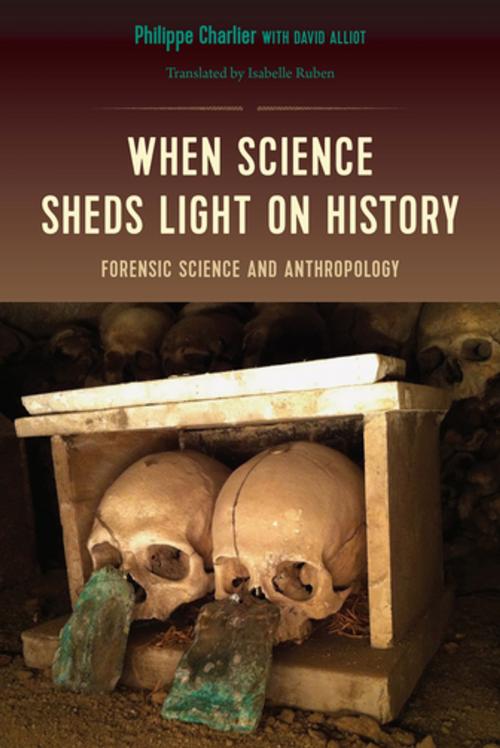When Science Sheds Light on History
Forensic Science and Anthropology
Nonfiction, Health & Well Being, Medical, Specialties, Forensic Medicine, Social & Cultural Studies, Social Science, Anthropology, History| Author: | Philippe Charlier | ISBN: | 9780813063300 |
| Publisher: | University Press of Florida | Publication: | August 24, 2017 |
| Imprint: | University Press of Florida | Language: | English |
| Author: | Philippe Charlier |
| ISBN: | 9780813063300 |
| Publisher: | University Press of Florida |
| Publication: | August 24, 2017 |
| Imprint: | University Press of Florida |
| Language: | English |
"Well written and hard to put down. For anyone with an interest in forensic science, this book is a must-read."--Nigel McCrery, author of Silent Witnesses: The Often Gruesome but Always Fascinating History of Forensic Science "This compilation is a fascinating read for the nonspecialist and will further serve as an inspirational set of recommended readings for the next generation of forensic scientists."--Tim D. White, coauthor of The Human Bone Manual
Did Richard the Lionheart really die from a simple crossbow wound, or was there foul play? Who are the two infants buried in Tutankhamun's tomb? Could a skull found in a tax collector's attic be the long-lost head of Henri IV? In When Science Sheds Light on History, Philippe Charlier, the "Indiana Jones of the graveyards," travels the globe to unravel these and other unsolved mysteries of human history.
To get answers, Charlier looks for clues in medical records, fingerprints, and bloodstains. He reconstructs the face of Robespierre from masks molded from his body after death and analyzes charred bones to see if they really are Joan of Arc's. He discovers lethal levels of gold in the hair and bones of King Henry II's mistress Diane de Poitiers, who used gold salts to "preserve her eternal youth."
Charlier also pieces together the stories of people whose names and lives have long been forgotten. He investigates Stone Age graves, medieval necropolises, and museum collections. Playing the role of both crime-scene investigator and forensic anthropologist, Charlier diagnoses a mummy with malaria, an ancient Greek child with Down syndrome, and a stately Roman with encephalitis. He also delves into ancient miracles and anomalies: a mute boy able to speak after making sacrifices to the gods, a woman pregnant for five years, and a serpent that cured a broken toe with its tongue.
Exploring how our ancestors lived and how they died, the forty cases in this book seek to answer some of history's most enduring questions and illustrate the power of science to reveal the secrets of the past.
"Well written and hard to put down. For anyone with an interest in forensic science, this book is a must-read."--Nigel McCrery, author of Silent Witnesses: The Often Gruesome but Always Fascinating History of Forensic Science "This compilation is a fascinating read for the nonspecialist and will further serve as an inspirational set of recommended readings for the next generation of forensic scientists."--Tim D. White, coauthor of The Human Bone Manual
Did Richard the Lionheart really die from a simple crossbow wound, or was there foul play? Who are the two infants buried in Tutankhamun's tomb? Could a skull found in a tax collector's attic be the long-lost head of Henri IV? In When Science Sheds Light on History, Philippe Charlier, the "Indiana Jones of the graveyards," travels the globe to unravel these and other unsolved mysteries of human history.
To get answers, Charlier looks for clues in medical records, fingerprints, and bloodstains. He reconstructs the face of Robespierre from masks molded from his body after death and analyzes charred bones to see if they really are Joan of Arc's. He discovers lethal levels of gold in the hair and bones of King Henry II's mistress Diane de Poitiers, who used gold salts to "preserve her eternal youth."
Charlier also pieces together the stories of people whose names and lives have long been forgotten. He investigates Stone Age graves, medieval necropolises, and museum collections. Playing the role of both crime-scene investigator and forensic anthropologist, Charlier diagnoses a mummy with malaria, an ancient Greek child with Down syndrome, and a stately Roman with encephalitis. He also delves into ancient miracles and anomalies: a mute boy able to speak after making sacrifices to the gods, a woman pregnant for five years, and a serpent that cured a broken toe with its tongue.
Exploring how our ancestors lived and how they died, the forty cases in this book seek to answer some of history's most enduring questions and illustrate the power of science to reveal the secrets of the past.















